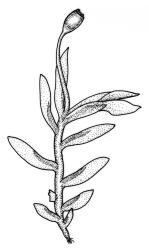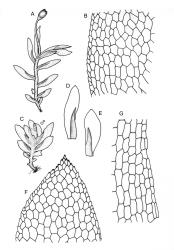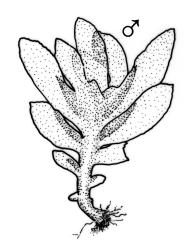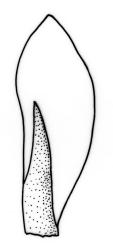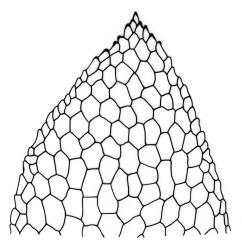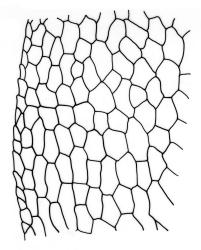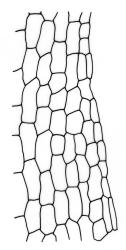Plants minute, 2–3 mm, delicate, loosely gregarious or as scattered individuals. Stems simple, pale, fleshy, with rhizoids at base only. Leaves in 3–8 pairs, distant, patent to patulous, plane when moist, loosely and irregularly crispate when dry, oblong-spathulate, 0.75–1.5 × 0.2–0.3 mm; apex broadly acute to obtuse; laminae unistratose; vaginant laminae ½–⅔ leaf length, partially closed; dorsal lamina reaching leaf insertion and often shortly decurrent; margins serrate in distal half of leaf, ± entire in proximal region; marginal cells distinct in 1–2 rows, shorter and narrower than adjacent laminal cells, thin-walled; cells of apical and dorsal laminae quadrate, rectangular, or hexagonal, smooth, non-bulging, thin-walled, (18–)25–40(–55) × 15–25 µm. Costa absent.
Dioicous. Perichaetia terminal; perichaetial leaves longer than vegetative leaves. Perigonia terminal, male plants smaller than female, leaves in up to 5 pairs. Setae colourless, fleshy, 1.5–2.0 mm; capsules erect, symmetric, 0.4–0.6 mm; exothecial cells in c. 32–42 columns; operculum erect-rostrate from a conic base, equal in length to theca. Peristome of scariosus-type; teeth with fimbriate adaxial trabeculae below the bifurcation, 30–40 µm wide at base. Calyptra smooth, mitrate. Spores 10–13 µm.
Dixon 1929, pl. 10, fig. 16; Sainsbury 1955, pl. 6, fig. 1; Beever et al. 2002, p. 34, figs 1–4. The leaf illustrations in the protologue are confusing in including an apparently forked costa, but the description is unambiguous: "costa nulla".
For distinctions from F. dealbatus, the only other ecostate Fissidens species known in N.Z., see there.
K; NI: N Auckland (Hunua Range), S Auckland (Kakepuku Scenic Reserve, Urewera National Park), Gisborne (Marumaru Caves), Wellington (Palmerston North, Percy Scenic Reserve).
Endemic.
On densely shaded rotting tree-fern trunks and leaf material, or rotting wood, occasionally on soil or rock, in indigenous forest. Recorded at elevations of 30–670 m (Paengaroa Scenic Reserve near Taihape, Wellington L.D.). Numerous collections of the species were made during the 1996 John Child Bryophyte Workshop in Urewera National Park, on the rotting rachides, laminae, and adventitious roots of Dicksonia fibrosa, growing deeply shaded on a stream bank in Dacrycarpus dacrydioides forest.
Dixon initially labelled the type specimen as "Fissidens filicola" Dixon sp. nov., with the substrate as "on tree-ferns", but "filicola" and "tree-ferns" have been crossed out and replaced in Dixon’s hand with "hylogenes" and "damp wood in shade" respectively.
Dixon annotated the label "Name altered because G. O. S [ainsbury]. writes that it was not growing on tree fern, but always on damp wood in shade". However, examination of the type specimens indicates that the holotype is on a mixture of tree-fern trunk and wood, and the isotype is on tree-fern aerial roots.
Fissidens hylogenes is listed as "Naturally Uncommon" in the N.Z. Threat Classification System (Glenny et al. 2011). It is, however, easily overlooked, owing to its small size and apparent preference for an unusual microhabitat for the genus. It is probably more common than records indicate, and should be looked for in the South I.



